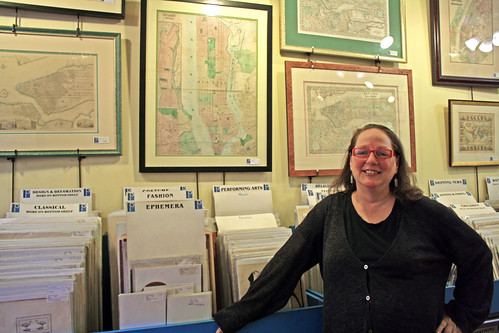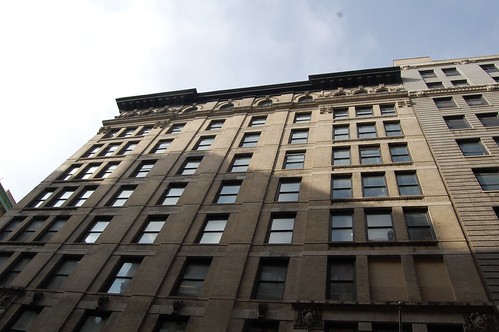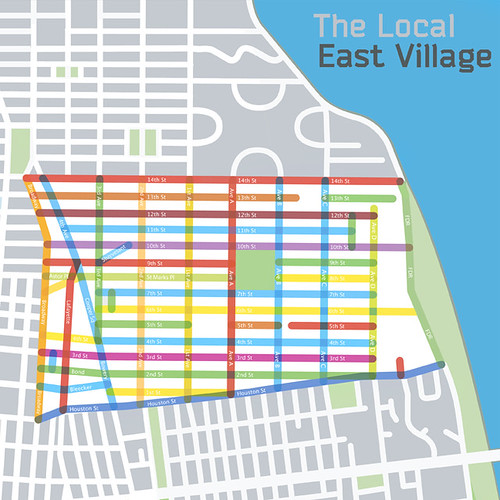For every East Village business that’s opening or closing, dozens are quietly making it. Here’s one of them: Pageant Print Shop.
 Lauren Carol SmithRebecca Solomon
Lauren Carol SmithRebecca SolomonIt’s been nearly two decades since Michael Caine and Barbara Hershey perused the Pageant Book Shop for a copy of E. E. Cummings in “Hannah and her Sisters,” but the store’s history goes back farther than that. In 1946, Sidney B. Solomon and Henry “Chip” Chafetz joined the ranks of Book Row, a stretch of mom-and-pop bookshops along Fourth Avenue from St. Marks Place to 14th Street. One of Mr. Solomon’s two daughters, Shirley, took over after her father died and then moved the store to West Houston Street after a rent hike in the 1990s.
Pageant became an online-only enterprise in 1999, only to reopen at 69 East Fourth Street after Shirley’s sister Rebecca moved back to the city. Nearly seven years later, the siblings are still selling hard-to-find items, though now maps and prints rather than rare books. “Some are old, some are very old, some are very, very old,” said Shirley during a recent conversation with The Local.
Q.
How does a shop that sells old maps stay in business?
A.
Shirley: I focus on the unique and affordable. I have things from $1 to $100, to $1,000. There’s an original David Roberts lithograph that is $3,000 framed. We get lots of foot traffic and sell a lot of things in the $1 to $4 range, which adds up. Read more…
 Matt Logan A view of the Brown Building, formerly the Asch Building, site of the Triangle Shirtwaist Fire.
Matt Logan A view of the Brown Building, formerly the Asch Building, site of the Triangle Shirtwaist Fire.One hundred years ago today, on a Saturday afternoon just before closing time, a waste basket caught fire on the eighth floor of the Asch Building, between Greene Street and Washington Plaza. The fire spread soundlessly. Beneath the methodical whir of sewing machines it swept across the floor and upwards and, ultimately, caught 500 packed-in workers in a panic. Those that fled to the ninth floor stairwell found the exits shut fast. Those that packed into the elevators found that only so many could fit. And those that the fire herded to windows found the ladders too short to reach the ground.
Fifty-four jumped.
Within half an hour, 146 workers perished in the Triangle Shirtwaist Factory Fire. Most of the victims were young, female immigrants, who had crossed over oceans in search of opportunity. What they found was a world that lacked adequate safety restrictions, wage requirements, and worker representation; all those things came after, when the public became galvanized by the blaze, setting the basis for legislative action and labor reform.
Roughly one out of three victims of the fire – 53 people – resided in the East Village. Every year descendants and union members alike gather at the former site of the Asch Building to recite their names along with the others as a gesture of respect and remembrance. This centennial anniversary will mark the first year that all the victim’s names are spoken. For decades, six victims of the fire were unknown until Michael Hirsch, an amateur historian, identified them earlier this year.
Now, their names will join the others after nearly a century of silence.
A Deadly Toll
This map, which lists the names and addresses of the victims of the Triangle Shirtwaist Fire who resided in the East Village, offers a stark illustration of the devastating toll that the blaze took on the neighborhood.
View 1911 Triangle Factory Fire: East Village Victims in a larger map
Map compiled by Kenan Christiansen.
Read comprehensive coverage of the anniversary of the fire in The Times.
 Matt Panuska
Matt PanuskaBroadway to the East River, 14th Street to Houston.
That’s how we define the boundaries of the East Village and the coverage area of this blog.
Do you think we’re on the mark or way off? What boundaries would you use to define the East Village?






